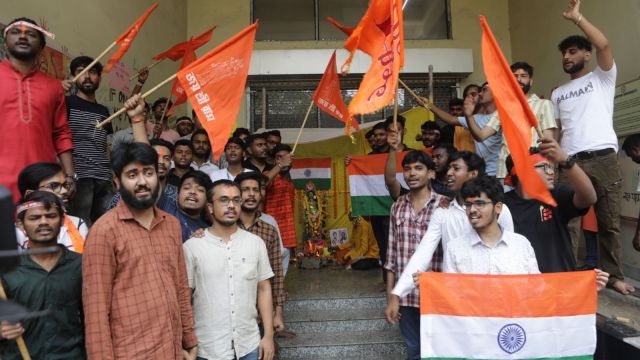
“Krittibas’s Ram is the compassionate, devotee-loving Ram. He redeems even the lowly and the sinful. He embraces Guhak, the Chandal as his friend. He blesses the forest animals, the monkeys, with his love”. These words (in translation) of Rabindranath Tagore are bound to come to one’s mind after watching the emergence of Ram Navami as a Bengali festival over the last 10 years. Krittibas’s Ramayana, once a must-read for Bengalis and which Tagore also read as a child, was different in essence from Valmiki’s Ramayana. Krittibas’s Ram was a Bengali Ram, the elder brother of a Bengali household and also a ruler for whom the well-being of his subjects takes priority over every other consideration. However, the image of Ram that we have been watching in flags and festoons in the last few years on the occasion of Ram Navami in West Bengal is a different one. This Ram looks aggressive, and often carries a sword with him. This Ram is not even Valmiki’s Ram. This is a Ram that aggressive Hindutva has manufactured in northern India, especially in Uttar Pradesh, and has transported to Bengal.
The rise of Ram Navami in West Bengal, in fact, coincides with the rise of BJP as a political force in the state. BJP’s rise as a significant opposition in Bengal (10 per cent votes in the 2016 Assembly elections, up from 5 per cent in 2011), and its massive growth in national elections in the state (a staggering 40 per cent vote share in 2019) — can be directly correlated with the rise of the weapon-brandishing Ram Navami celebrations. In April 2017, Dilip Ghosh, then the state BJP president, and his allies announced that Bengal would witness a “show” on the day of Ram Navami that year. Indeed, Bengal, arguably for the first time in its history, witnessed a display of saffron-headbanded devotees of Ram. The intervening years witnessed violent parades by armed Ram devotees and communal clashes in minority-populated areas.
This year, the festival did not witness any untoward incidents. Initially, there was an attempt on the part of Trinamool Congress to distance itself from the Ram Navami festival. But this year, the visibility of the leaders of Trinamool Congress in the parades was quite prominent. One should not also forget that in 2024, Ram Navami was even granted the status of a “government holiday” in the state. It should also be noted that while Ram Navami parades initially involved mostly Hindi-speaking communities and areas — such as those near jute mills and the Asansol industrial belt — by 2024–2025, their presence has become widespread across the state.
It is becoming gradually evident that Ram Navami has already become a part of Bengali culture. Sociologists are giving different reasons for its success in penetrating Bengali culture. Some have argued that the politics of polarisation has made Hindus more explicitly Hindu and Muslims more explicitly Muslim in Bengal. Competitive communalism practised by the two major political parties of the state has also been identified as a cause for the rise and consolidation of the festival in the state. It has also been said that in regions of Bengal such as Jangalmahal where fear-mongering about Muslims has limited scope, Ram has made an entry by riding on the shoulders of Hanuman. In those areas, there has indeed been a significant rise in the numbers of Hanuman temples.
One should add another one to this list of explanations: The absence of a Bengali Ram in today’s Bengal, who is not warrior-like, but rather soft by nature and compassionate towards his subjects, owes a lot to the impact of Bollywood and Hindi television serials on our culture. A Bengali wedding ceremony today, instead of informal addas in which songs were sung and poems recited, has a very formal and well-organised sangeet. It also has haldi instead of gaye halud. Sometimes, the groom even comes on a horse. The rampant “Hindi-isation” of our culture has indeed paved the way for its“Hinduisation”. The rise of Ram Navami as a Bengali festival, thus, is not merely political but also socio-cultural.
It is clear that the festival is going to stay in Bengal as a Bengali festival. It won’t be wise now to question how far Ram is a Bengali god. What is needed instead is an attempt to bring back the Bengali Ram in the celebrations of Ram Navami. Tagore once wrote about Valmiki’s Ram, “Every act of Rama’s life reflects generosity, valour, and forbearance. India has not forgotten that he was a friend to the Chandala, a god to the monkeys, and a companion to Bibhishana. His glory does not lie in destroying his enemies, but in winning them over. He transcended the prohibitions of custom and the barriers of social prejudice; he built a bridge of love between the Aryan and the non-Aryan”. It is high time that Bengal remembers this other side of Ram: Ram who is an emblem of love, not war.
The writer is professor, Department of English and Culture Studies, and director, Centre for Australian Studies, University of Burdwan